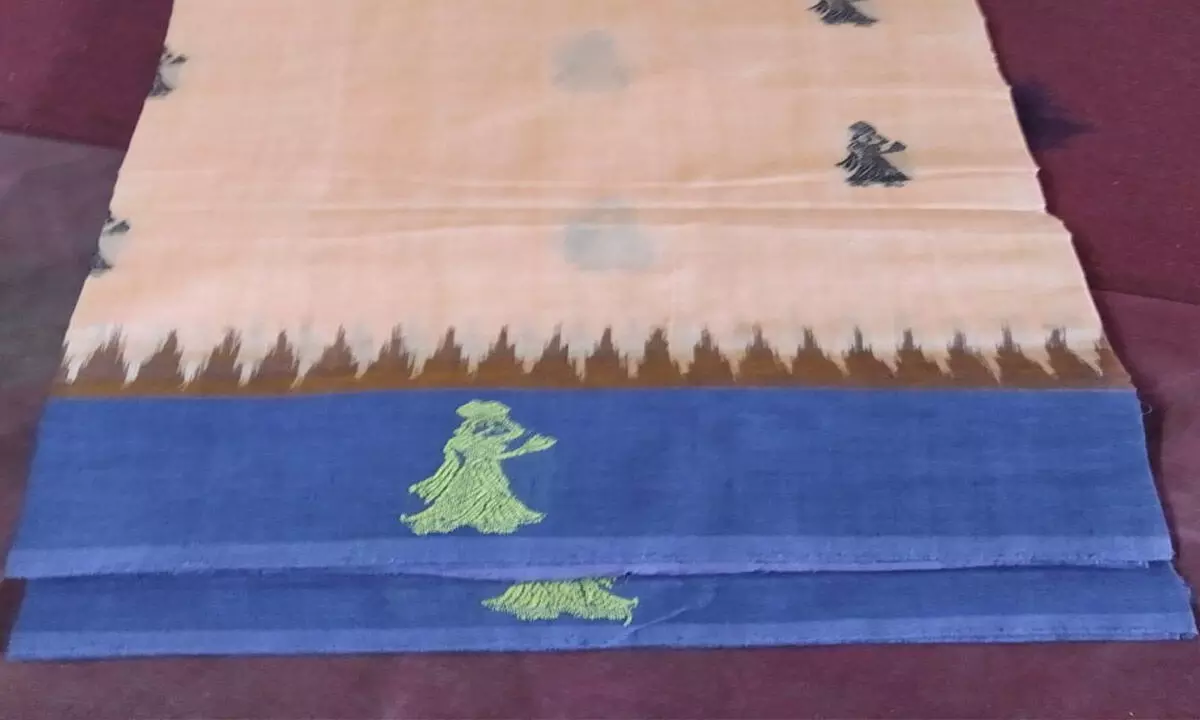Live
- South Korea's ruling party leader cancels press conference amid calls for resignation
- AIADMK's big meet discusses 2026 polls, prospective alliances
- BJP questions Congress-Shiv Sena (UBT) alliance over Aaditya Thackeray's Savarkar-Nehru remark
- Maha Oppn to boycott customary CM tea meet, cites rising farmers' distress, atrocities against Dalits
- Mikheil Kavelashvili is new Georgian President
- He makes things look easy: Smith on 241-run partnership with Head
- Decline in TB cases & deaths in India ‘remarkable’, shows ‘political commitment’, says former WHO Director
- PKL 11: Delhi dedicates win over Haryana to ‘junior express’
- Cyclone kills 14 in French territory Mayotte
- 3rd Test: Head, Smith centuries flatten India on Day 2
Just In
Hyderabad: Gollabhamma weavers hanging by a thread as investment soars


8 The Gollabhama saree has been granted geographical indication (GI 2012) status for its distinctive weave style
- The Gollabhama sarees from the Siddipet region of Telangana State are known for their unique inlay weaving technique and motif called ‘Gollabhama’ or milkmaid
- The figurative design is first drawn on a graph and then woven in a pattern generally using 80-100 threads
- This predicament has regrettably caused a discernible decline in both weavers’ enthusiasm and the overall sales trajectory
Hyderabad: The art of crafting Gollabhamma sarees, while inherently exquisite, has encountered a significant setback as a result of the formidable financial investments required. This predicament has regrettably caused a discernible decline in both weavers’ enthusiasm and the overall sales trajectory.
The Gollabhama sarees from the Siddipet region of Telangana State are known for their unique inlay weaving technique and motif called ‘Gollabhama’ or milkmaid. Typically, Gollabhama, Kolatam and Bathukamma motifs are used in textile weaving, on cotton, silk and si-co (a silk and cotton blend).
The figurative design is first drawn on a graph and then woven in a pattern generally using 80-100 threads. The Gollabhama saree has been granted geographical indication (GI 2012) status for its distinctive weave style.
Speaking to The Hans India, P. Mallesham, Durga Bhavani ChenethaSahakara Sangam, says, “The art of crafting these illustrious sarees demands substantial capital infusion for production, setting it apart from the typical handlooms prevalent in Telangana. Consequently, a prevailing lack of fervour among weavers ensues, necessitating significant financial backing.
Adding to their predicament, the meagre remuneration garnered from each saree’s intricate making and designing compels them to gravitate towards alternative vocational avenues. Regrettably, this confluence of factors has led to a noticeable wane in weavers’ enthusiasm for the intricate weaving of Gollabhama sarees.”
In the Siddipet saree creations, there are three themes that recur in different designs namely ‘Kolatam’ (community circular dancing with sticks),‘Bathukamma’ (also a form of circular dancing while rhythmically clapping hands) and ‘Gollabhama’ (scenes of milkmaids, carrying pots of milk, milking cows, churning butter of herding cows).
The fabric is meticulously woven with an emphasis on robustness, longevity, and substantial texture. Initially tailored to cater to the needs of the Golla community, these sarees later garnered acclaim among connoisseurs of fine cotton craftsmanship. This distinctive Siddipet weave has also gained recognition under the name of the tie and dye technique.
Siddipet’s Golabhama sarees epitomise purity through their exclusive use of high-quality cotton, often employing a solitary hue within the motif to accentuate the intricacies of the design. These sarees predominantly showcase a palette of organic shades, occasionally augmented by additional colors to create harmonious and complementary blends.
One exceptional fact about this design is that the image cannot be printed or embroidered, but only woven with utmost care. Gollabhama motifs are woven in a straight line across the width of the saree. No zari is used.
Mudigonda Srinivas, Siddipet Handloom Weaver Cooperative Production and Sales Society Limited says, “The inherent challenge lies not solely in the production process but also in the commendable yet moderately elevated pricing of the saree, ranging between Rs.1800 to 2000.
To remain relevant amidst the evolving times, there exists a pressing need to embrace novel designs and innovative techniques, thereby ushering in a refreshing spectrum of offerings. Regrettably, a significant proportion of contemporary weavers struggle to intricately imprint the Gollabhama motif onto the fabric, a formidable feat indeed.”
“The art of crafting these illustrious sarees demands substantial capital infusion for production, setting it apart from the typical handlooms prevalent in Telangana. Consequently, a prevailing lack of fervour among weavers ensues, necessitating significant financial backing. Adding to their predicament, the meagre remuneration garnered from each saree’s intricate making and designing compels them to gravitate towards alternative vocational avenues. Regrettably, this confluence of factors has led to a noticeable wane in weavers’ enthusiasm for the intricate weaving of Gollabhama sarees.”
- P. Mallesham, Durga Bhavani,
“The inherent challenge lies not solely in the production process but also in the commendable yet moderately elevated pricing of the saree, ranging between Rs.1800 to 2000. To remain relevant amidst the evolving times, there exists a pressing need to embrace novel designs and innovative techniques, thereby ushering in a refreshing spectrum of offerings. Regrettably, a significant proportion of contemporary weavers struggle to intricately imprint the Gollabhama motif onto the fabric, a formidable feat indeed.”
- Mudigonda Srinivas, Siddipet Handloom
Weaver Cooperative Production and Sales Society Limited

© 2024 Hyderabad Media House Limited/The Hans India. All rights reserved. Powered by hocalwire.com






